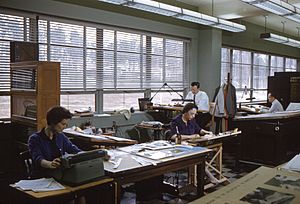Graphic arts facts for kids
Graphic arts is a term that describes the skills used to create visual things, like drawings, prints, and designs. It's all about making pictures and words look great! In the past, it mostly meant printmaking and drawing. Today, it refers to the work of a graphic designer or a print technician. Graphic arts has been around for a very long time, ever since people first started stamping images or words.
Contents
What Are Graphic Arts?
Graphic arts involves making images and text for many different purposes. It's about communicating ideas or messages visually. This field combines art and technology to create designs that are both beautiful and useful.
Tools and Techniques
People who work in graphic arts use many tools. In the past, they used pens, brushes, inks, and printing presses. Today, they often use computers and special software. Some common techniques include:
- Drawing: Creating images by hand or with digital tools.
- Painting: Using colors to make pictures.
- Printmaking: Making copies of an image, like with a stamp or a printing machine.
- Photography: Taking pictures with a camera.
- Digital design: Using computer programs to create graphics, layouts, and animations.
Where You See Graphic Arts
Graphic arts are all around you! You see them every day in many places:
- Books and magazines: The way the text is laid out, the pictures, and the cover designs.
- Websites and apps: The look and feel of the pages, the buttons, and the icons.
- Advertisements: Posters, billboards, and online ads that catch your eye.
- Logos and branding: The unique symbols and colors that represent companies or products.
- Packaging: The designs on cereal boxes, toy boxes, and other product containers.
- Movies and games: The visual effects, character designs, and user interfaces.
A Brief History of Graphic Arts
The history of graphic arts is very long and interesting. It goes back thousands of years!
Early Beginnings
Long ago, people used graphic arts to tell stories and share information.
- Cave paintings: Some of the earliest examples are drawings on cave walls made by ancient humans.
- Ancient Egypt: Egyptians used hieroglyphs, which were picture-based writing, and created beautiful illustrations on papyrus.
- Calligraphy: In many cultures, like China and Japan, writing itself became an art form, known as calligraphy.
The Printing Revolution
A huge change happened with the invention of the printing press.
- Woodblock printing: Around the 7th century, people in China started using carved wooden blocks to print text and images.
- Gutenberg's press: In the 1400s, Johannes Gutenberg invented the movable type printing press in Europe. This made it much easier and faster to print books. It helped spread knowledge and ideas to many more people.
Modern Graphic Arts
As technology grew, so did graphic arts.
- Industrial Revolution: In the 18th and 19th centuries, new printing methods like lithography made it possible to print colorful posters and advertisements. This was important for businesses.
- Photography: The invention of photography in the 19th century added a new way to create images.
- Computers and Digital Age: In the late 20th century, computers changed everything. Graphic designers could now create and edit designs digitally. This led to amazing new possibilities for animation, web design, and more.
Graphic Arts Today
Today, graphic arts is a huge field with many different jobs. People who work in graphic arts are often called graphic designers.
What Does a Graphic Designer Do?
A graphic designer uses their creativity and skills to solve visual problems. They might:
- Create a new logo for a company.
- Design a website layout.
- Make illustrations for a children's book.
- Design the packaging for a new product.
- Create posters for a concert or event.
- Develop the look of a video game.
They need to understand colors, shapes, fonts, and how people see and react to images. They also need to be good at using design software.
Importance of Graphic Arts
Graphic arts is very important in our world. It helps us:
- Communicate: Visuals can explain complex ideas quickly.
- Inform: Infographics and diagrams make facts easier to understand.
- Persuade: Advertisements and campaigns use strong visuals to convince people.
- Entertain: Movies, games, and comics rely heavily on graphic arts.
- Brand: Companies use unique designs to stand out and be remembered.
So, next time you see a cool poster, a fun app, or an interesting book cover, remember that it's all thanks to the amazing world of graphic arts!
Related pages
Images for kids
See also
 In Spanish: Artes gráficas para niños
In Spanish: Artes gráficas para niños



